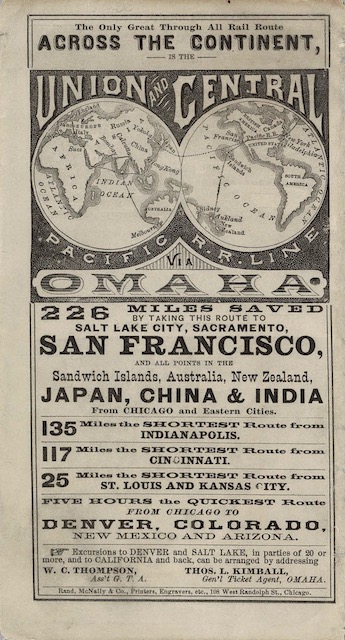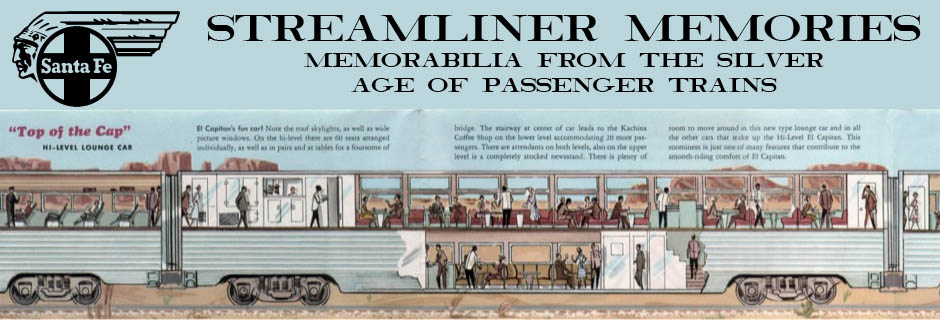As a part of his map collection, David Rumsey included more than 50 brochures that had a railroad map on one side and timetables on the other. Most of these timetables were printed by Rand McNally and followed a standard format. Instead of being a booklet like most 20th-century timetables, they unfolded to be 18 to 40 inches wide and 9 to 18 inches high. One side had a map of the railroad and the other had the timetables, often with other useful information and advertisements.
 Click image to download a 6.3-MB PDF of this timetable, which is from the David Rumsey map collection.
Click image to download a 6.3-MB PDF of this timetable, which is from the David Rumsey map collection.
We’ve already seen a few of them, but over the next couple of months I’m going to present nearly 50 more in order to trace the history of passenger train names. The timetables range from 1872 to 1907, which seems to cover the period during which most railroads went from no-name trains to names for at least their main passenger trains.
Today’s timetable covers the Union Pacific-Central Pacific trains between Omaha and Oakland in 1872. It apparently precedes the standard format described above, instead having information and a small map on one side and the timetable and a few woodcuts on the other.
The schedule shows three trains a day between the two endpoints, with one called “Express,” a second called “Mixed,” and the third called “Freight.” The brochure advertises “Pullman’s Palace Cars,” which I suspect were only available on the Express train. The Express train is also the only one that shows meal stops and the only one that carried an observation car through the most scenic portions of the trip.
The brochure says the time from Omaha to San Francisco was 4 days and 6 hours, but as I read the timetable, it took 4 days and 10 hours, leaving Omaha at 11:30 am and arriving in San Francisco (including a 30-minute ferry ride) on the fifth day at 8:30 pm. All stops on the Central Pacific were on San Francisco time, and while the timetable doesn’t say so, I suspect all stops on the Union Pacific were on what we would call Mountain Time, as the only time change shown is in Ogden where the railroads met. If Omaha was two hours different from San Francisco (as it is today), then the time from Omaha to San Francisco was 4 days and 11 hours.
Note: A reader correctly points out that it is more likely that the UP stops were on local time as time zones hadn’t been invented yet. Still, around 4 days and 11 hours seems a likely time for this journey as Omaha time wouldn’t have been far different from two hours off of San Francisco time.
Either way, the average speed was about 18 miles per hour. The mixed and freight trains were much slower, taking more than 6-1/2 days from Omaha to Oakland for average speeds of about 12 miles per hour.
“Express,” of course, wasn’t a train name but a type of train. In this case, it meant that the train didn’t take time picking up or dropping off freight cars along the way. Still, the express train made every stop shown for the mixed and freight trains. Later trains would be called “limiteds,” meaning that they only made some stops along the route, thus saving more time.
